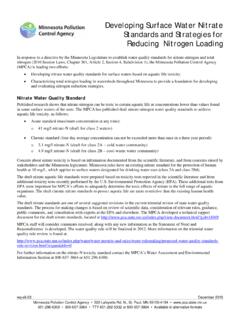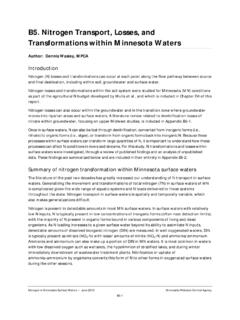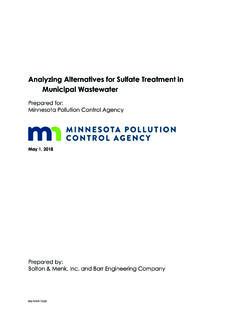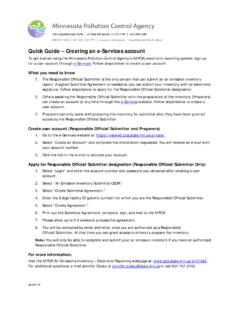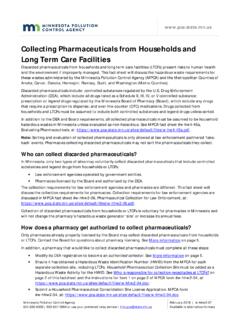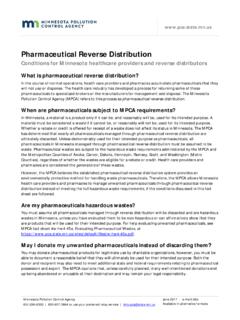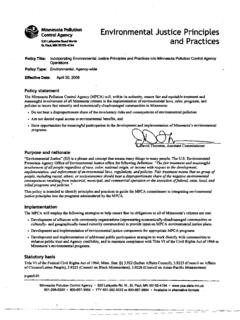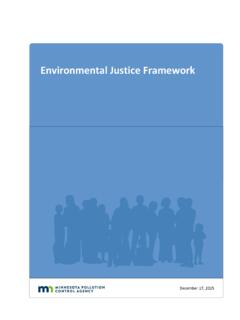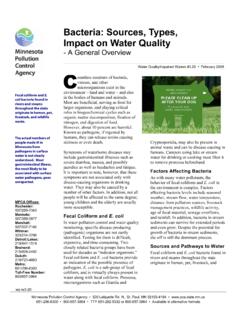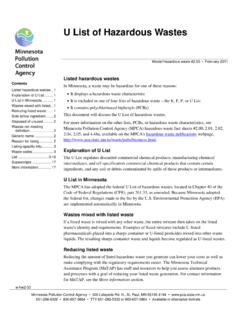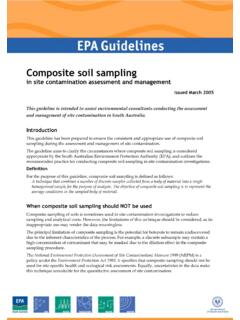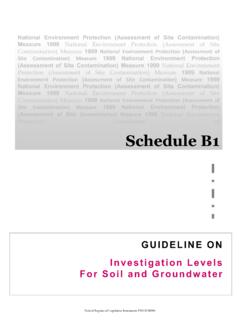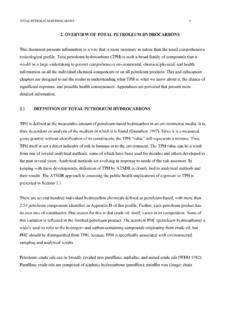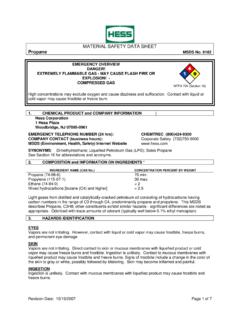Transcription of F List of Hazardous Waste
1 F List of Hazardous Wastes Subtitle Waste / Hazardous Waste # January 2011. Listed Hazardous wastes Contents In Minnesota, a Waste may be Hazardous for one of these reasons: Listed Hazardous wastes .1. F list in Minnesota ..1 It displays a Hazardous Waste characteristic Reducing listed Waste ..1 It is recorded in one of four lists of Hazardous Waste the K, F, P, or U List Wastes mixed with listed It contains polychlorinated biphenyls (PCBs). Waste ..1. Explanation of This fact sheet will discuss the F List of Hazardous Waste . Waste codes ..2 For more information on the other lists, PCBs, or Hazardous Waste characteristics, see Spent solvents ..3 Minnesota Pollution Control Agency (MPCA) Hazardous Waste fact sheets # , , , Metal treating ..4 , , and , available on the MPCA's Hazardous Waste publications webpage, Manufacturing and processing.
2 4. Discarded unused products ..5 F List in Minnesota Contaminated soil The MPCA has adopted the federal F List of Hazardous Waste , located in Chapter 40 of the treatment Code of Federal Regulations (CFR), parts and , as amended. Because Wood Minnesota adopted the federal list, changes made to the list by the Environmental Petroleum refinery ..6 Protection Agency (EPA) are implemented automatically in Minnesota. Landfill leachate ..6. Explanation of Reducing listed Waste superscripts ..6. More information ..8 Reducing the amount of listed Hazardous Waste you generate can lower your costs as well as make complying with the regulatory requirements easier. The Minnesota Technical Assistance Program (MnTAP) has staff and resources to assist you in assessing alternate products and processes to help reduce your listed Waste generation. For contact information for MnTAP, see the 'More information' section on page six.
3 Wastes mixed with listed Waste If a listed Waste is mixed with any other Waste , the entire mixture then takes on the listed Waste 's identity and requirements. Examples of listed mixtures include F-listed solvents sprayed over or into a parts washer and F-listed solvents applied to a sorbent for wiping. The resulting parts washer Waste and sorbents become regulated as F-listed wastes. For more information on managing sorbents used with Hazardous Waste solvents, see MPCA. Hazardous Waste fact sheet # , Managing Towels, Wipes, and Sorbents, available on the MPCA's Hazardous Waste publications webpage. w-hw2-00. Minnesota Pollution Control Agency 520 Lafayette Rd. N., St. Paul, MN 55155-4194 651-296-6300 800-657-3864 TTY 651-282-5332 or 800-657-3864 Available in alternative formats Explanation of F List Reason for listing Each group of wastes on the F List (list) was included for one or more of the following reasons, identified in the list by the capitalized letters in parentheses following the definition: Ignitable (I).
4 Reactive (R). Toxic (T). Acutely Hazardous (H). Acutely Hazardous F-listed wastes The wastes listed for being acutely Hazardous (H) are F020, F021, F022, F023, F026, and F027. These wastes are subject to more restrictive requirements than other Hazardous wastes, including generator size calculation, accumulation limits, and empty container determinations. For more information on managing acutely Hazardous wastes, see MPCA Hazardous Waste fact sheet # , P List of Acutely Hazardous Waste , available on the MPCA's Hazardous Waste publications webpage. Listing-specific information Many wastes on the F List have additional listing-specific information associated with them, including definitions and possible exemptions. This information is referenced in this fact sheet by the numbers in superscript following the reason for listing. Explanation of the numbers is given after the complete list in this document.
5 Although the MPCA has included the most common particulars in this guidance document, the EPA may have issued additional interpretation. Waste codes A four-character Hazardous Waste code is assigned to each group of wastes on the list. Use this code for annual reporting and manifesting. The list below is grouped according to the type of Waste . In alphabetical order: Contaminated soil treatment residues (F028). Discarded unused products (F027). Landfill leachate (F039). Manufacturing and processing (F020-F026). Metal treating (F006-F012 and F019). Petroleum refinery (F037-F038). Spent solvents (F001-F005). Wood preserving (F032-F035). *Reserved (No listings currently use codes F013-F018, F029-F031, F033 or F036). The following list is grouped in numerical order of the Waste codes. F List of Hazardous Waste w-hw2-00 January 2011. page 2. Spent solvents (F001 F005).
6 F001 These spent halogenated solvents used in degreasing; spent solvent mixtures used in degreasing containing, before use, a total of 10 percent or more by volume of these solvents or the solvents listed in F002, F004, or F005, and still bottoms from the reclamation of these spent solvent and spent solvent mixtures used in degreasing. (T)1. carbon tetrachloride chlorinated fluorocarbons methylene chloride tetrachloroethylene, also called perchloroethylene 1,1,1-trichloroethane trichloroethylene, also called 'TCE'. F002 These spent halogenated solvents; spent solvent mixtures containing, before use, a total of 10 percent or more by volume of these solvents or the solvents listed in F001, F004, or F005, and still bottoms from the reclamation of these spent solvent and spent solvent mixtures. (T)1. chlorobenzene methylene chloride ortho-dichlorobenzene tetrachloroethylene, also called 'perchloroethylene'.
7 1,1,1-trichloroethane 1,1,2-trichloroethane trichloroethylene, also called 'TCE'. trichlorofluoromethane 1,1,2-trichloro-1,2,2-trifluoroethane F003 These spent non-halogenated solvents; spent solvent mixtures containing, before use, either only these non- halogenated solvents, or one or more of these non-halogenated solvents and a total of 10 percent or more by volume of the solvents listed in F001, F002, F004, or F005, and still bottoms from the reclamation of these spent solvent and spent solvent mixtures. (I)1,2. acetone cyclohexane ethyl acetate ethyl benzene ethyl ether methanol methyl isobutyl ketone n-butyl alcohol xylene F004 These spent non-halogenated solvents; spent solvent mixtures containing, before use, a total of 10 percent or more by volume of these solvents or the solvents listed in F001, F002, or F005, and still bottoms from the reclamation of these spent solvent and spent solvent mixtures.
8 (T)1. cresols and cresylic acid nitrobenzene F List of Hazardous Waste w-hw2-00 January 2011. page 3. F005 These spent non-halogenated solvents; spent solvent mixtures containing, before use, a total of 10 percent or more by volume of these solvents or the solvents listed in F001, F002, or F004, and still bottoms from the reclamation of these spent solvent and spent solvent mixtures. (I,T)1. benzene carbon disulfide 2-ethoxyethanol isobutanol methyl ethyl ketone, also called 'MEK'. 2-nitropropane Pyridine toluene Metal treating (F006-F012 and F019). F006 All wastewater treatment sludges from electroplating operations except those from these processes. However, these sludges may still be Hazardous for a Hazardous Waste characteristic. (T). sulfuric acid anodizing of aluminum tin plating of carbon steel zinc plating (segregated basis) on carbon steel aluminum or zinc aluminum plating on carbon steel cleaning/stripping associated with tin, zinc, and aluminum plating on carbon steel chemical etching and milling of aluminum F007 Spent cyanide plating bath solutions from electroplating operations.
9 (R,T). F008 Plating bath sludges from the bottom of plating baths from electroplating operations where cyanides are used in the process. (R,T)3. F009 Spent stripping and cleaning bath solutions from electroplating operations where cyanides are used in the process. Sludges formed in electroplating stripping and cleaning bath solution tanks where cyanides are used in the process are also included. (R,T)3. F010 Quenching bath residues from oil baths from metal heat-treating operations where cyanides are used in the process. (R,T)3. F011 Spent cyanide solutions from salt bath pot cleaning from metal heat-treating operations. (R,T). F012 Quenching Waste water treatment sludges from metal heat treating operations where cyanides are used in the process. (R,T)3. F019 Wastewater treatment sludges from the chemical conversion coating of aluminum except from zirconium phosphating in aluminum can washing when such phosphating is an exclusive conversion coating process.
10 (T)4. Manufacturing and processing (F020-F026). F020 Wastes (except wastewater and spent carbon from hydrogen chloride purification) from the production or manufacturing use (as a reactant, chemical intermediate, or component in a formulating process) of tri- or tetrachlorophenol, or of intermediates used to produce their pesticide derivatives. (H)5,6. F List of Hazardous Waste w-hw2-00 January 2011. page 4. F021 Wastes (except wastewater and spent carbon from hydrogen chloride purification) from the production or manufacturing use (as a reactant, chemical intermediate, or component in a formulating process) of pentachlorophenol, or of intermediates used to produce its derivatives. (H)5. F022 Wastes (except wastewater and spent carbon from hydrogen chloride purification) from the manufacturing use (as a reactant, chemical intermediate, or component in a formulating process) of tetra-, penta-, or hexachlorobenzenes under alkaline conditions.
